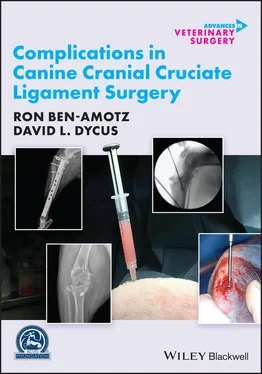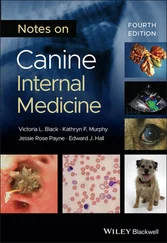The use of preoperative antimicrobials is most often associated with a distant active infection, most commonly associated with wound and skin infections [70]. The use of preoperative antimicrobials has been associated with an increased risk for SSI and as such, postponement of elective orthopedic cases requiring preoperative antimicrobials is recommended [2]. Misuse and overuse of antimicrobials are known to contribute to antimicrobial resistance, therefore avoiding the potential for SSI development by postponing surgery in the face of active antimicrobial use should limit the animal's risk of developing a multidrug‐resistant SSI.
The use of perioperative antimicrobials for reduction of SSI is widely practiced in veterinary medicine. Few studies exist in veterinary medicine that provide insight into the appropriate timing for administration of perioperative antimicrobials. Therefore, guidelines followed for perioperative antimicrobial prophylaxis are largely adapted from human medicine. Current guidelines in human medicine state that an appropriate antimicrobial should be administered at least 60 minutes before the first surgical incision to allow time to achieve high serum levels, readministration of said antimicrobial should be performed every two half‐lives, and antimicrobial administration should be discontinued within 24 hours of surgery [81]. A few older veterinary studies provide evidence for perioperative antimicrobial prophylaxis as a protective factor against SSI development. These studies suggest that administration of antimicrobials should be limited to procedures longer than 90 minutes, the first dose of antimicrobial should be administered within 30 minutes of the first surgical incision, and if used appropriately, perioperative antimicrobial prophylaxis can reduce the SSI rate by 6–7 times [2, 7, 82].
Recently, appropriate perioperative antimicrobial administration has been documented to be received by 42.5–85% of animals [13, 83, 84]. Generally, more animals receive an appropriately timed first dose than those requiring additional dosing over the course of surgery. However, in one study, the previously recommended initial dosing of perioperative antimicrobial administration 30 minutes before incision was challenged, as antimicrobial administration 60 minutes or more before incision was protective against development of SSI in a cohort of animals undergoing TPLO procedures [84]. In another study, inappropriate timing of perioperative administration was not significantly associated with the development of an SSI [13]. As this is a single finding, further supportive evidence is required before considering this association to be true and thus alter perioperative antimicrobial prophylaxis recommendations.
At this time, evidence suggests that there is major room for improvement regarding compliance of perioperative antimicrobial prophylaxis, and implementation of a preoperative surgical safety checklist may improve compliance rates [67]. This lack of compliance may be leading to increased SSI rates being reported. Current recommendations for orthopedic antimicrobial prophylaxis include the use of cefazolin (22 mg/kg), administered 30 minutes before the first surgical incision, readministration every 90 minutes intraoperatively until skin closure, and discontinuation of antimicrobial therapy within 24 hours of surgery.
While perioperative antimicrobial prophylaxis is recommended to be discontinued within 24 hours of surgery, a definition of when perioperative prophylaxis ends and postoperative antimicrobial therapy begins remains unknown. In human medicine, it is rare for antimicrobials to be continued beyond 24–48 hours postoperatively, even in the case of transplanted organs. Despite this knowledge, the increased incidence of SSI in clean elective orthopedic procedures has led to an increased use of postoperative antimicrobials. This is a controversial topic amongst veterinary surgeons, with evidence to both support and refute its use. Several studies including mainly TPLO surgeries, fewer TTA surgeries and some broad clean orthopedic procedures have identified a protective effect against SSI when postoperative antimicrobials are used [4, 9, 13, 21, 22, 30, 70, 83]. Fewer studies have identified a lack of effect on alteration of the SSI rate when postoperative antimicrobials are administered [8, 14, 16, 27, 29]. Additional studies identify postoperative antimicrobial use in clean orthopedic procedures including TPLO and the Arthrex Canine Cruciate Ligament Repair Anchor System™, without evaluating their effect on SSI rates [12, 19, 28, 52].
At this time, there are a greater number of studies to support the use of postoperative antimicrobial use following TPLO surgery; however, the duration of treatment has been variable and specific recommendations cannot be made, although short courses of 3–5 days' duration are likely sufficient. Further prospective evaluation of postoperative antimicrobial protocols should be considered. Many factors can contribute to an individual's estimated risk for developing an SSI and these should be considered together before deciding to use postoperative antimicrobials. Postoperative antimicrobials should never be used as a surrogate for aseptic technique and good surgical practices.
Infection control in veterinary medicine tends to be reactive instead of proactive. SSIs are often identified only when animals present for clinical signs associated with SSIs or when incidentally identified during a routine follow‐up examination. This is considered to be a form of passive surveillance, where no specific effort is made to identify SSIs [68]. Alternatively, active surveillance occurs when specific outcomes or indicators are sought to increase the rate of detection [85].
The goals of an active SSI surveillance program are to create a monitoring system that will determine the baseline level of expected SSI within a facility. By determining the baseline, a critical limit (a value beyond the expected SSI rate) can be established to determine when interventions should be employed to reduce the risk of SSI [84]. For active surveillance to be universal, definitions of outcomes must be provided. This would require defining what constitutes an SSI (see Chapter 3for further details) as well as defining clinical signs that may be associated with an SSI and thus warrant further direct investigation of the patient. In relation to postoperative SSIs, active surveillance can be achieved through scheduled owner contact using telephone interviews or electronic questionnaires or by communication with referring veterinarians [1, 86]. During this contact, questions can be posed with regard to incisional healing, local tissue recovery, limb use, as well as if medical interventions have been required. Ideally, these forms of communication would be performed more than once during the patient's recovery period, encompassing timeframes associated with early development (within 30 days of surgery) and late development of SSI (within 90 days of surgery) [87].
In veterinary medicine, two prospective studies using active postdischarge surveillance for assessment of SSIs identified that 27.8–35% of all SSIs would have been missed without active surveillance [1, 86]. This is not an insignificant finding and therefore should encourage the development of active surveillance practices for SSI assessment.
Overall, TPLO has higher reported rates of SSI than other methods of stifle stabilization for cranial cruciate ligament ruptures (6,10,12–20,22,24,25). This may be due to the increased soft tissue dissection, thermal necrosis of the bone, and increased surgical times compared to extracapsular repairs. When compared to other tibial osteotomies, the overall higher incidence of SSIs may only be due to the increased frequency with which TPLOs are performed and thus reported.
Читать дальше












